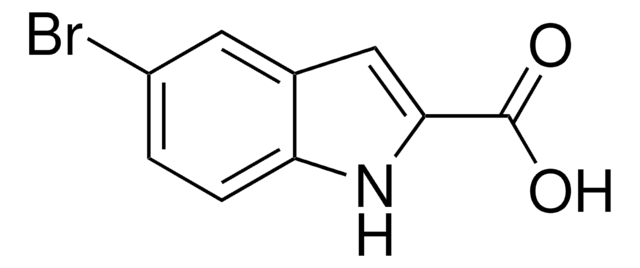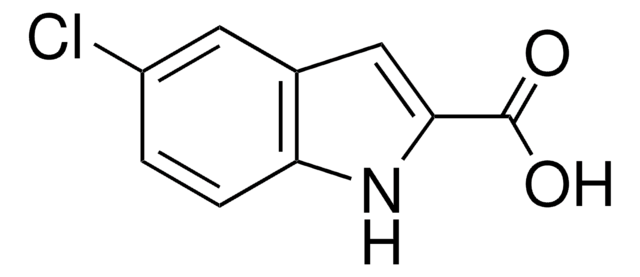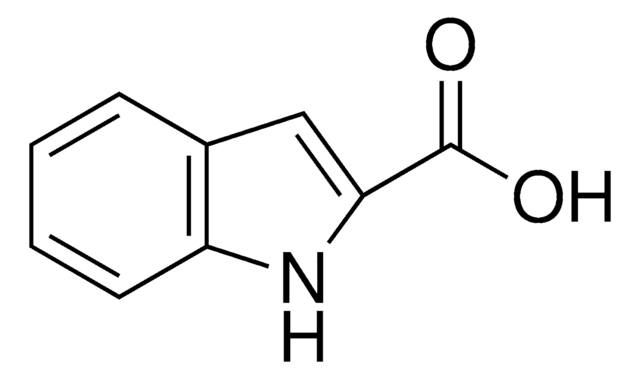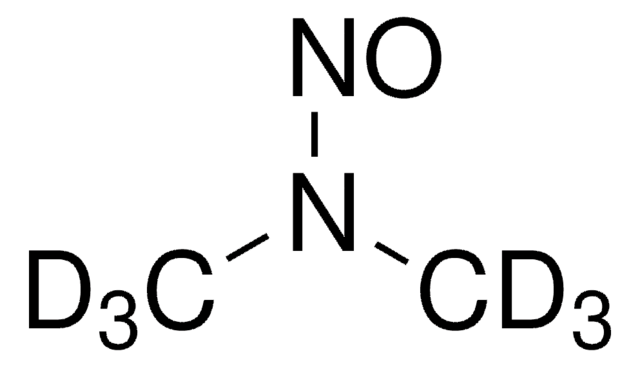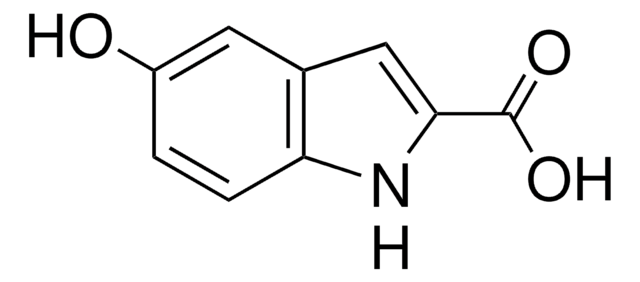265128
5-Fluoroindole-2-carboxylic acid
99%
Se connecterpour consulter vos tarifs contractuels et ceux de votre entreprise/organisme
About This Item
Formule empirique (notation de Hill):
C9H6FNO2
Numéro CAS:
Poids moléculaire :
179.15
Numéro CE :
Numéro MDL:
Code UNSPSC :
12352100
ID de substance PubChem :
Nomenclature NACRES :
NA.22
Produits recommandés
Niveau de qualité
Essai
99%
Forme
solid
Pf
259 °C (dec.) (lit.)
Groupe fonctionnel
carboxylic acid
fluoro
Chaîne SMILES
OC(=O)c1cc2cc(F)ccc2[nH]1
InChI
1S/C9H6FNO2/c10-6-1-2-7-5(3-6)4-8(11-7)9(12)13/h1-4,11H,(H,12,13)
Clé InChI
WTXBRZCVLDTWLP-UHFFFAOYSA-N
Catégories apparentées
Description générale
5-Fluoroindole-2-carboxylic acid is an antagonist of the glycine site within the NMDA (N-methyl-D-aspartate) receptor complex.
Application
Reactant for the synthesis of:
- Fungicidal agents
- Antitumor agents
- 2,3-dioxygenase (IDO) inhibitors
- Factor Xa inhibitors
- Enantioselective D3 receptor antagonists
- Ligands for hFPRL1 (or ALXR) receptor in inflammation
- Antibacterial agents
- Inhibitors of hepatitis C virus NS3·4A protease
Mention d'avertissement
Warning
Mentions de danger
Conseils de prudence
Classification des risques
Eye Irrit. 2 - Skin Irrit. 2 - STOT SE 3
Organes cibles
Respiratory system
Code de la classe de stockage
11 - Combustible Solids
Classe de danger pour l'eau (WGK)
WGK 3
Point d'éclair (°F)
Not applicable
Point d'éclair (°C)
Not applicable
Équipement de protection individuelle
dust mask type N95 (US), Eyeshields, Gloves
Faites votre choix parmi les versions les plus récentes :
Déjà en possession de ce produit ?
Retrouvez la documentation relative aux produits que vous avez récemment achetés dans la Bibliothèque de documents.
R Kapoor et al.
Clinical and experimental pharmacology & physiology, 25(3-4), 216-219 (1998-05-20)
1. The effects of the specific N-methyl-D-aspartate (NMDA)-glycine site antagonist 5-fluoro indole-2-carboxylic acid (FICA) and NMDA, microinjected into the vasodepressor caudal ventrolateral medulla, were compared in spontaneously hypertensive rats (SHR) and in Wistar-Kyoto (WKY) rats. 2. 5-Fluoro indole-2-carboxylic acid elicited
R Bakshi et al.
Neuroscience letters, 110(1-2), 113-117 (1990-03-02)
Intrathecal (i.t.) administration of the opioid dynorphin causes neurological dysfunction and tissue damage. It has been suggested that these effects of dynorphin may be mediated, in part, by N-methyl-D-aspartate (NMDA) receptors. In the present studies, recently developed compounds that block
R Kamiński et al.
Journal of neural transmission (Vienna, Austria : 1996), 105(2-3), 133-146 (1998-07-11)
5-Fluoroindole-2-carboxylic acid, an antagonist of the glycine site within the NMDA receptor complex, administered intraperitoneally in doses of 150 and 200 mg/kg, 120 min before electroconvulsions, significantly raised the convulsive threshold from 6.8 to 7.9 and 8.3 mA, respectively. At
Chung-Yi Wu et al.
Chemistry & biology, 13(3), 261-268 (2006-04-28)
Severe acute respiratory syndrome (SARS) is caused by a newly emerged coronavirus that infected more than 8000 individuals and resulted in more than 800 fatalities in 2003. Currently, there is no effective treatment for this epidemic. SARS-3CL(pro) has been shown
T J Grudt et al.
Molecular pharmacology, 37(4), 477-481 (1990-04-01)
Whole-cell and single-channel patch-clamp recordings from hippocampal neurons in culture have been used to study the receptor channel selectivity of the glutamate analog quisqualate. The dose-response relationship of quisqualate acting at the N-methyl-D-aspartate (NMDA) receptor was measured as that portion
Notre équipe de scientifiques dispose d'une expérience dans tous les secteurs de la recherche, notamment en sciences de la vie, science des matériaux, synthèse chimique, chromatographie, analyse et dans de nombreux autres domaines..
Contacter notre Service technique